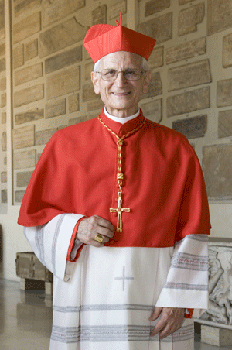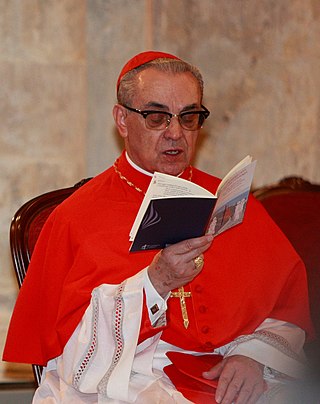
The Holy See, also called the See of Rome, Petrine See or Apostolic See, is the jurisdiction of the Pope in his role as the bishop of Rome. It includes the apostolic episcopal see of the Diocese of Rome, which has ecclesiastical jurisdiction over the Catholic Church and sovereignty over the city-state known as Vatican City.
The Roman Curia comprises the administrative institutions of the Holy See and the central body through which the affairs of the Roman Catholic Church are conducted. The Roman Curia is the institution which the Roman Pontiff ordinarily makes use of in the exercise of his supreme pastoral office and universal mission in the world. It is at the service of the Pope, successor of Peter, and of the Bishops, successors of the Apostles, according to the modalities that are proper to the nature of each one, fulfilling their function with an evangelical spirit, working for the good and at the service of communion, unity and edification of the Universal Church and attending to the demands of the world in which the Church is called to fulfill its mission.

Crescenzio Sepe is an Italian prelate of the Catholic Church who served as Archbishop of Naples from 2006 to 2020. He served in the Roman Curia as Prefect of the Congregation for the Evangelization of Peoples from 2001 to 2006. He was made a cardinal in 2001. Before that he spent 25 years in increasingly important positions in the Roman Curia.
The Dicastery for Interreligious Dialogue, previously named Pontifical Council for Interreligious Dialogue (PCID), is a dicastery of the Roman Curia, erected by Pope Paul VI on 19 May 1964 as the Secretariat for Non-Christians, and renamed by Pope John Paul II on 28 June 1988.

Paul Joseph Jean Poupard is a French prelate of the Catholic Church who has been a Cardinal since 1985. He held positions in the Roman Curia for more than 25 years, serving as President of the Pontifical Council for Culture from 1988 to 2007 and briefly as President of the Pontifical Council for Interreligious Dialogue.

Jean-Louis Pierre Tauran was a French cardinal of the Catholic Church. When he died, he had been the president of the Pontifical Council for Interreligious Dialogue since 2007 and Camerlengo of the Holy Roman Church since the end of 2014. He was made a cardinal in 2003 and was the Cardinal Protodeacon from 2011 to 2014. His earlier career included almost thirty years in the diplomatic service of the Holy See and several years as the Vatican's chief archivist and librarian.

The Dicastery for the Clergy, formerly named Congregation for the Clergy, is the dicastery of the Roman Curia responsible for overseeing matters regarding priests and deacons not belonging to religious orders. The Congregation for the Clergy handles requests for dispensation from active priestly ministry, as well as the legislation governing presbyteral councils and other organisations of priests around the world. The Congregation does not deal with clerical sexual abuse cases, as those are handled exclusively by the Congregation for the Doctrine of the Faith.
The Secretariat of State is the oldest dicastery in the Roman Curia, the central papal governing bureaucracy of the Catholic Church. It is headed by the Cardinal Secretary of State and performs all the political and diplomatic functions of the Holy See. The Secretariat is divided into three sections, the Section for General Affairs, the Section for Relations with States, and, since 2017, the Section for Diplomatic Staff.

The Dicastery for the Eastern Churches, previously named Congregation for the Oriental Churches or Congregation for the Eastern Churches, is a dicastery of the Roman Curia responsible for contact with the Eastern Catholic churches for the sake of assisting their development and protecting their rights. It also maintains whole and entire in the one Catholic Church the heritage and canon law of the various Eastern Catholic traditions. It has exclusive authority over the following regions: Egypt and the Sinai Peninsula, Eritrea and northern Ethiopia, southern Albania and Bulgaria, Cyprus, Greece, Iran, Iraq, Lebanon, Israel, Syria, Jordan and Turkey, and also oversees jurisdictions based in Romania, Southern Italy, Hungary, India and Ukraine.
In the Roman Curia, a congregation is a type of department of the Curia. They are second-highest-ranking departments, ranking below the two Secretariats, and above the pontifical councils, pontifical commissions, tribunals and offices.

Franc Rode is a Slovenian cardinal of the Catholic Church. He is the prefect emeritus of the Dicastery for Institutes of Consecrated Life and Societies of Apostolic Life, having served as prefect from 2004 to 2011. He was elevated to the cardinalate in 2006.

Leonardo Sandri is an Argentine prelate of the Catholic Church who has been a cardinal since November 2007 and vice dean of the College of Cardinals since January 2020. He was prefect of the Congregation for the Eastern Churches from 2007 to 2022. He served in the diplomatic service of the Holy See from 1974 to 1991 in several overseas assignments, including as permanent observer of the Holy See before the Organization of American States from 1989 to 1991, and in Rome as Substitute for General Affairs in the Secretariat of State from 1999 to 2007.
Pastor bonus is an apostolic constitution promulgated by Pope John Paul II on 28 June 1988. It instituted a number of reforms in the process of running the central government of the Catholic Church.

Raffaele Farina SDB is an Italian cardinal of the Catholic Church. He was Archivist of the Vatican Secret Archives, Librarian of the Vatican Library, and president of Scuola Vaticana di Paleografia, Diplomatica e Archivistica. Farina was elevated to the cardinalate in 2007.

Stanisław Marian Ryłko is a Polish Cardinal of the Roman Catholic Church. He held positions in the Roman Curia beginning in 1987 and was president of the Pontifical Council for the Laity from 2003 to 2016. He was made a cardinal in 2007. He has been Archpriest of the Basilica of Santa Maria Maggiore since 28 December 2016.
Pope Paul VI's reform of the Roman Curia was accomplished through a series of decrees beginning in 1964, principally through the apostolic constitution Regimini Ecclesiae universae issued on 15 August 1967.
The Pontifical Council for Promoting the New Evangelization, also translated as Pontifical Council for Promoting New Evangelization, was a pontifical council of the Roman Curia whose creation was announced by Pope Benedict XVI at vespers on 28 June 2010, eve of the Feast of Saints Peter and Paul, to carry out the New Evangelization. On 5 June 2022, the department was merged into the Dicastery for Evangelization.

Pontificalis Domus was a motu proprio document issued by Pope Paul VI on 28 March 1968, in the fifth year of his pontificate. It reorganized the Papal Household, which had been known until then as the Papal Court.

Santos Abril y Castelló is a Spanish prelate of the Catholic Church. After a career in the diplomatic corps of the Holy See, he held a number of positions in the Roman Curia and from 2011 to 2016 was Archpriest of the Basilica of Santa Maria Maggiore.
Praedicate evangelium is an apostolic constitution reforming the Roman Curia and was published and promulgated on 19 March 2022 by Pope Francis; the document took effect on 5 June 2022.













